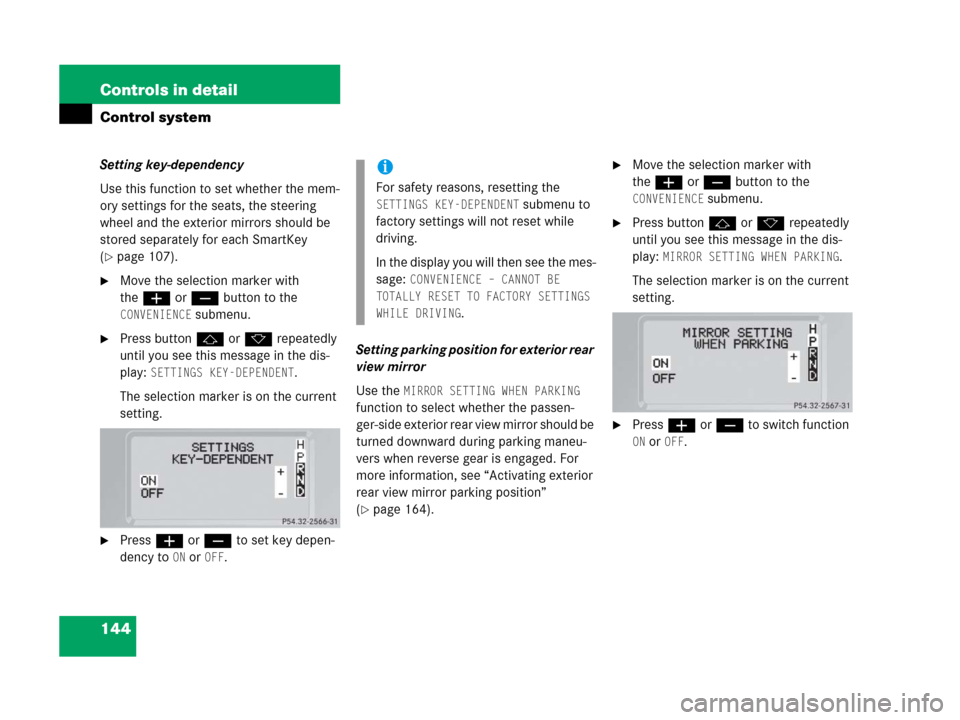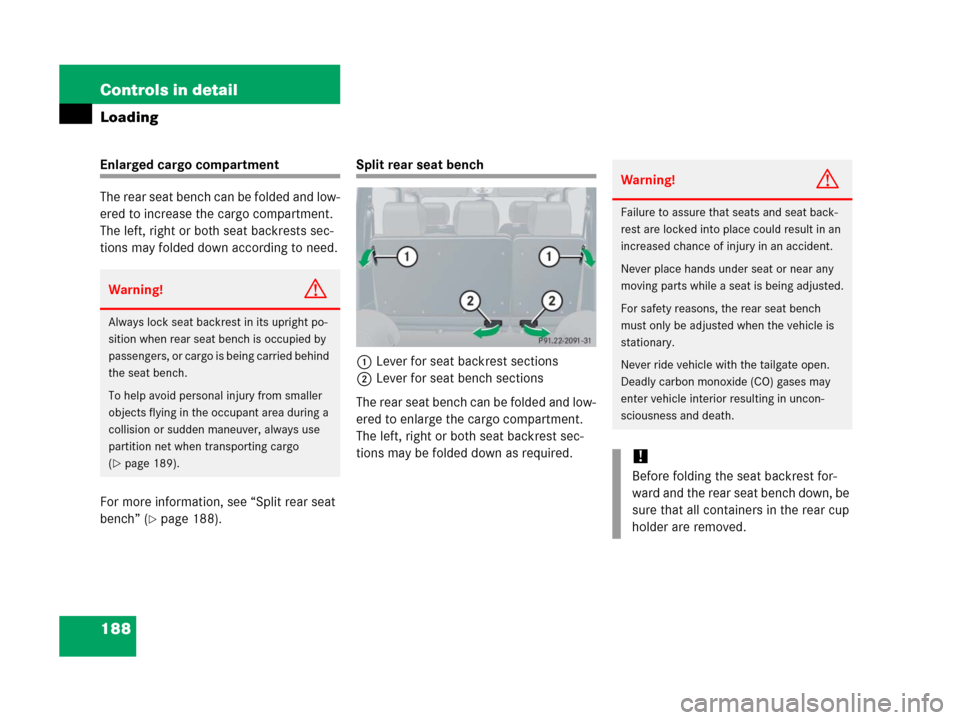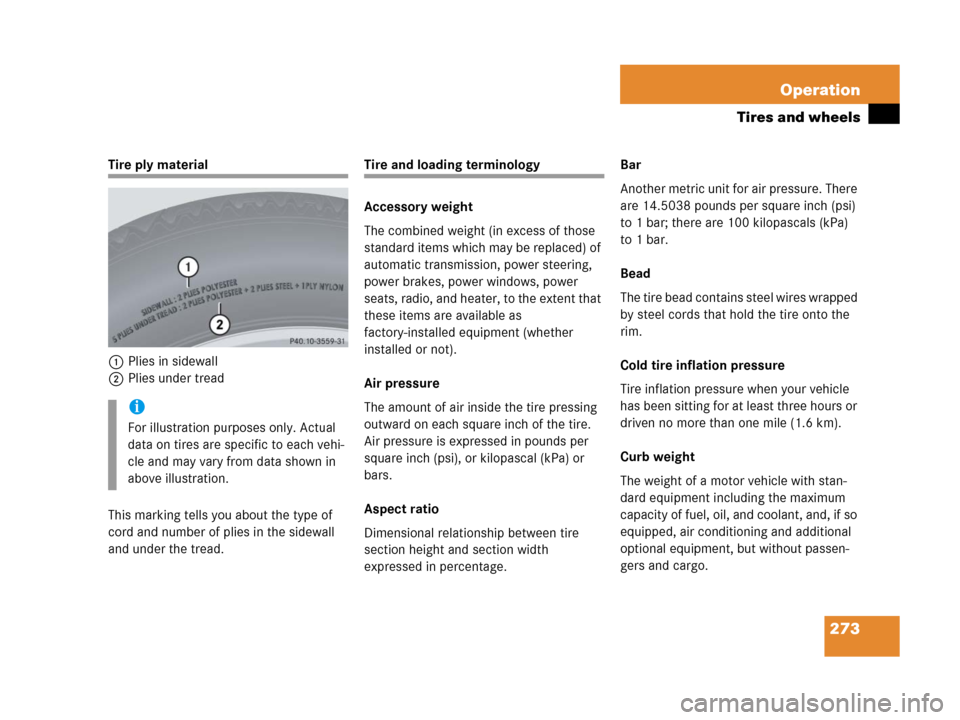Page 109 of 417
108 Controls in detail
Memory function
1Memory button
2Stored position buttons
�Switch on the ignition (�page 35).
or
�Open the respective door and insert
the SmartKey in the starter switch.
Storing positions into memory
�Adjust the seats, steering wheel and
exterior rear view mirrors to the de-
sired position (
�page 37).
�Press memory button1.
�Release memory button and push posi-
tion button2 within three seconds.
All the settings are stored at the select-
ed position.
Recalling positions from memory
�Press and hold position button2 until
the seat, steering wheel and rear view
mirrors have fully moved to the stored
positions.
i
Releasing the button immediately
stops movement to the stored posi-
tions.
Warning!G
Do not operate the power seats using the
memory button if the seat backrest is in an
excessively reclined position. Doing so
could cause damage to front or rear seats.
First move seat backrest to an upright posi-
tion.
Page 145 of 417

144 Controls in detail
Control system
Setting key-dependency
Use this function to set whether the mem-
ory settings for the seats, the steering
wheel and the exterior mirrors should be
stored separately for each SmartKey
(
�page 107).
�Move the selection marker with
theæ orç button to the
CONVENIENCE submenu.
�Press buttonj ork repeatedly
until you see this message in the dis-
play:
SETTINGS KEY-DEPENDENT.
The selection marker is on the current
setting.
�Pressæ orç to set key depen-
dency to
ON or OFF. Setting parking position for exterior rear
view mirror
Use the
MIRROR SETTING WHEN PARKING
function to select whether the passen-
ger-side exterior rear view mirror should be
turned downward during parking maneu-
vers when reverse gear is engaged. For
more information, see “Activating exterior
rear view mirror parking position”
(
�page 164).
�Move the selection marker with
theæ orç button to the
CONVENIENCE submenu.
�Press buttonj ork repeatedly
until you see this message in the dis-
play:
MIRROR SETTING WHEN PARKING.
The selection marker is on the current
setting.
�Pressæ orç to switch function
ON or OFF.
i
For safety reasons, resetting the
SETTINGS KEY-DEPENDENT submenu to
factory settings will not reset while
driving.
In the display you will then see the mes-
sage:
CONVENIENCE – CANNOT BE
TOTALLY RESET TO FACTORY SETTINGS
WHILE DRIVING
.
Page 189 of 417

188 Controls in detail
Loading
Enlarged cargo compartment
The rear seat bench can be folded and low-
ered to increase the cargo compartment.
The left, right or both seat backrests sec-
tions may folded down according to need.
For more information, see “Split rear seat
bench” (
�page 188).
Split rear seat bench
1Lever for seat backrest sections
2Lever for seat bench sections
The rear seat bench can be folded and low-
ered to enlarge the cargo compartment.
The left, right or both seat backrest sec-
tions may be folded down as required.
Warning!G
Always lock seat backrest in its upright po-
sition when rear seat bench is occupied by
passengers, or cargo is being carried behind
the seat bench.
To help avoid personal injury from smaller
objects flying in the occupant area during a
collision or sudden maneuver, always use
partition net when transporting cargo
(
�page 189).
Warning!G
Failure to assure that seats and seat back-
rest are locked into place could result in an
increased chance of injury in an accident.
Never place hands under seat or near any
moving parts while a seat is being adjusted.
For safety reasons, the rear seat bench
must only be adjusted when the vehicle is
stationary.
Never ride vehicle with the tailgate open.
Deadly carbon monoxide (CO) gases may
enter vehicle interior resulting in uncon-
sciousness and death.
!
Before folding the seat backrest for-
ward and the rear seat bench down, be
sure that all containers in the rear cup
holder are removed.
Page 190 of 417

189 Controls in detail
Loading
Folding seat backrest forward
�Remove the head restraints
(
�page 102).
�Pull release lever1 in direction of ar-
row and fold seat backrest forward un-
til it locks in place.
Folding seat bench forward
�Fold seat backrest forward.
�Pull release lever2 in direction of ar-
row and fold seat bench forward to-
gether with the seat backrest.Returning seat bench and seat back-
rest to sitting position
�Fold up seat bench until it locks in
place.
�Pull release lever1 and raise seat
backrest until it locks in place.
�Check to make sure the seat is locked
by pushing and pulling on the seat
backrest.
Partition net* (MB Accessory)
Use of the partition net is a particularly im-
portant safety factor when the vehicle is
loaded higher than the top of the seat
backrests with smaller objects.
While the partition net will help protect you
from smaller objects, it cannot prevent the
movement of large, heavier objects into
the passenger area in an accident. Such
items must be properly secured using the
cargo tie-down rings in the cargo compart-
ment floor.
The partition net can be installed behind
the seat backrests of the rear seat bench,
or behind the front seats if the rear seat
bench is folded down.
Warning!G
Failure to assure that seats and seat back-
rests are locked into place could result in an
increased chance of injury in an accident.
i
Installation can be performed by open-
ing the rear doors.
Page 192 of 417
191 Controls in detail
Loading
Installation behind front seats
1Partition net
2Mounting
�Fold rear seat bench fully forward
(
�page 188).
�Engage partition net1 in
mountings2.3Lift tensioner
4Tie down
5Hook
6Ring
Lift tensioner3 must point in the direc-
tion of the cargo compartment.
�Set the length of tie downs4 and lift
tensioner3 to the rings6.
�Insert tie down hooks5 in rings6.
�Pull loose ends of tie downs4 until
net is tight.
After driving a short-distance, check the
tension of the partition net, retighten if
necessary.Removing partition net
�Lift tensioner upward to a horizontal
position to release tensioning of strap.
�Disengage tie down hooks from rings.
�Remove partition net from mountings.
Storing partition net
�Roll up partition net and secure it.
�Store partition net behind rear seat
bench.
Page 194 of 417

193 Controls in detail
Loading
�Always place items being carried
against front or rear seat backrests,
and fasten them as securely as possi-
ble.
�The heaviest portion of the cargo
should always be kept as low as possi-
ble against front or rear seat backrest
since it influences the handling charac-
teristics of the vehicle.
�For additional safety when transporting
cargo while the rear seats are unoccu-
pied, fasten the outer seat belts cross-
wise into the opposite side buckles.
�Always pad off sharp edges.
Cargo tie-down rings
The cargo compartment is provided with
four tie-down anchors.
Carefully secure cargo by applying even
load on all rings with rope of sufficient
strength to hold down the cargo.
i
The rear cargo compartment is the pre-
ferred place to carry objects. The en-
larged cargo compartment (rear seats
folded) should only be used for items
which do not fit in the rear cargo com-
partment alone.
Warning!G
While the partition net will help protect you
from smaller objects, it cannot prevent the
movement of large, heavier objects into the
passenger area in an accident.
Such items must be properly secured using
the cargo tie-down rings in the cargo com-
partment floor.
Page 199 of 417
198 Controls in detail
Useful features
Storage bags
Storage bags are located on the rear side
of the front seats.Ashtrays
Center console ashtray
1Ashtray
2Cigarette lighter
3Cover plate
Opening ashtray
�Briefly push the cover plate3.
The ashtray opens automatically.Removing the ashtray insert
4Sliding knob
5Astray insert
Warning!G
Do not place heavy or fragile objects, or ob-
jects having sharp edges in the storage
bags.
In an accident, during hard braking or sud-
den maneuvers, they could be thrown
around inside the vehicle and cause injury to
vehicle occupants.
Warning!G
Remove ashtray only with vehicle standing
still. Turn off the engine and set the parking
brake. Otherwise the vehicle might move as
a result of unintended contact with the gear
selector lever.
Page 274 of 417

273 Operation
Tires and wheels
Tire ply material
1Plies in sidewall
2Plies under tread
This marking tells you about the type of
cord and number of plies in the sidewall
and under the tread.Tire and loading terminology
Accessory weight
The combined weight (in excess of those
standard items which may be replaced) of
automatic transmission, power steering,
power brakes, power windows, power
seats, radio, and heater, to the extent that
these items are available as
factory-installed equipment (whether
installed or not).
Air pressure
The amount of air inside the tire pressing
outward on each square inch of the tire.
Air pressure is expressed in pounds per
square inch (psi), or kilopascal (kPa) or
bars.
Aspect ratio
Dimensional relationship between tire
section height and section width
expressed in percentage.Bar
Another metric unit for air pressure. There
are 14.5038 pounds per square inch (psi)
to 1 bar; there are 100 kilopascals (kPa)
to 1 bar.
Bead
The tire bead contains steel wires wrapped
by steel cords that hold the tire onto the
rim.
Cold tire inflation pressure
Tire inflation pressure when your vehicle
has been sitting for at least three hours or
driven no more than one mile (1.6 km).
Curb weight
The weight of a motor vehicle with stan-
dard equipment including the maximum
capacity of fuel, oil, and coolant, and, if so
equipped, air conditioning and additional
optional equipment, but without passen-
gers and cargo.
i
For illustration purposes only. Actual
data on tires are specific to each vehi-
cle and may vary from data shown in
above illustration.